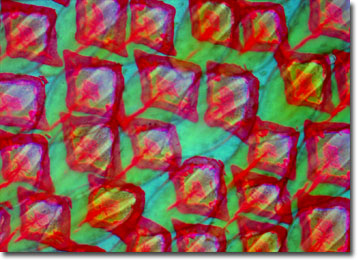Fluorescence Digital Image Gallery
Dogfish Shark Placoid Scales
Dogfish is the common name used to refer to many small sharks belonging to several different families. The best known are the spiny dogfishes, which belong to the family Squalidae.

Spiny dogfishes feature two spines, one in front of each fin, that contain venom in certain species. The sharks may be found in most marine waters of the world, but migrate seasonally in order to stay in areas that fall into a preferred temperature range. They also favor deep waters and are often bottom-dwellers. The fierce predators feed on a wide variety of fishes and invertebrates, sometimes to the chagrin of those working in the fishing industry. In a turn of food chain fair play, however, the sharks are themselves sometimes eaten by humans, primarily in European countries.
The bodies of dogfishes, like all sharks, are externally lined with placoid scales, also known as dermal denticles. The scales, which unlike other types of fish scales do not get larger as the shark grows, are similar in structure to teeth, consisting of three layers: a hard outer enamel-like layer, a middle stratum of dentine, and a central vascular pulp cavity. The scales are arranged in a slanting pattern pointed towards the tail of the shark that helps decrease the amount of friction the animal incurs while swimming. If the surface of a shark is rubbed from head to tail, it feels smooth, but stroking the animal in the opposite direction causes it to feel very rough. Due to this fact, sharkskin has been used as sand paper for hundreds of years and was known as shagreen by European cabinetmakers.
BACK TO THE FLUORESCENCE DIGITAL IMAGE GALLERY
